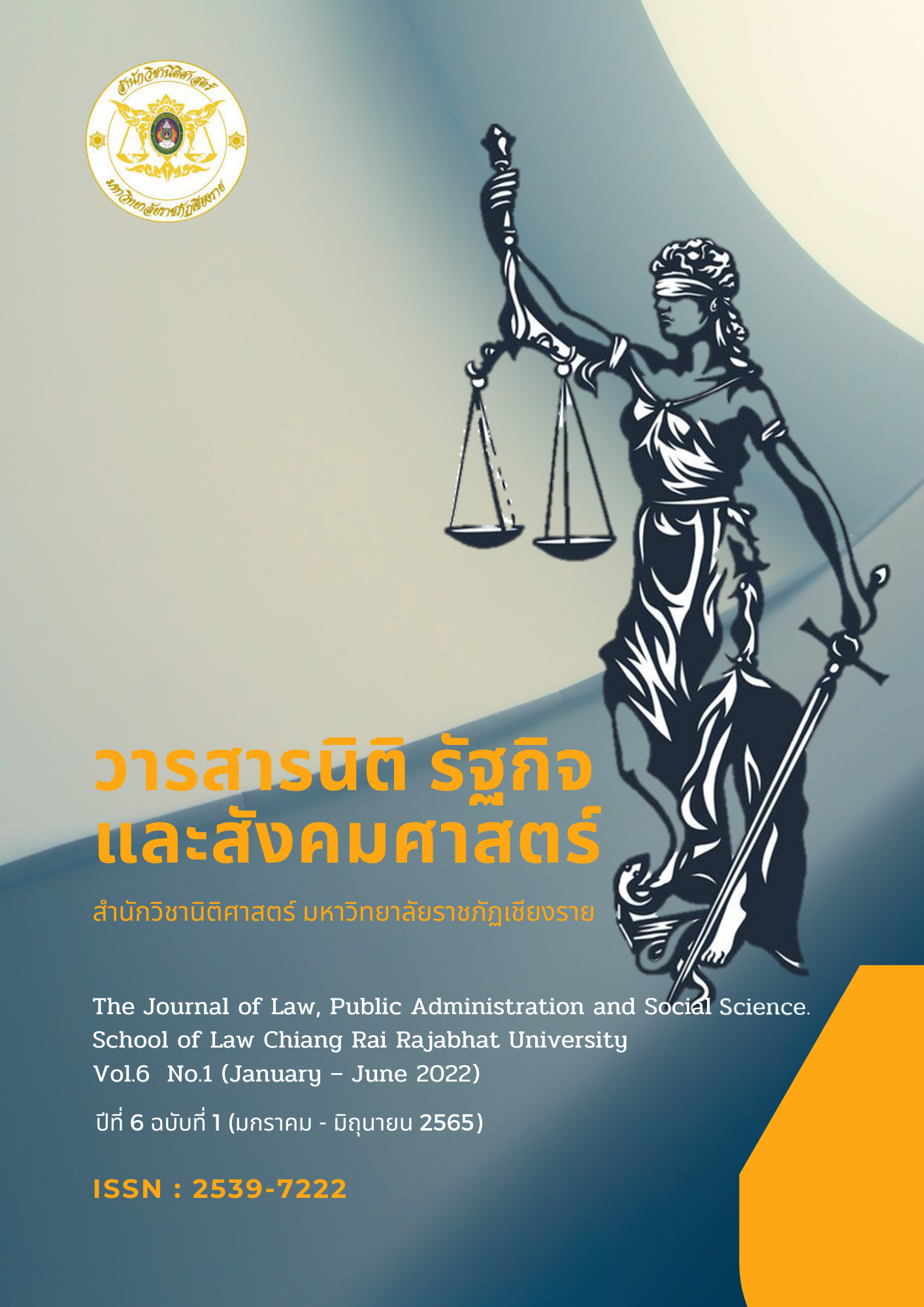Spatial Analysis for TB management in Chiang Rai Province
Main Article Content
Abstract
This research about Spatial Analysis for TB management is aimed to study about 3 objectives are 1) to analyze the prevalence and density of tuberculosis patients in Chiang Rai Province, 2) to analyze tuberculosis epidemic risk areas in Chiang Rai Province, and 3) to propose a spatial management guideline for tuberculosis patients in Chiang Rai Province. This study was based on the prevalence and density of TB patients in Chiang Rai Province. Using geographic information system to apply with the information from the Public Health Office, Chiang Rai. There were 1,112 TB patients in the year 2019, analysis of the prevalence and density of tuberculosis patients classified by sub-district. The results showed that the areas with the highest number of TB cases were Doi Hang and Rob Wiang sub-districts. The area with the highest prevalence rate in Doi Hang Subdistrict, followed by Doi Lan Subdistrict and Huai Sak Subdistrict, respectively. The areas with the highest density of tuberculosis patients were Wiang Subdistrict, Mueang Chiang Rai District, followed by Rob Wiang Subdistrict and Doi Hang Subdistrict, respectively. When the prevalence and density of TB patients were analyzed together, three risk areas are Doi Hang sub-district, Wiang sub-district and Rong Wiang sub-district, respectively. The guideline of Spatial management for tuberculosis patients includes target area selection for personnel allocation / budget / Time period, inform a regulation, proactive services and health behaviors and creating or developing tuberculosis treatment networks.
Article Details
References
กรมควบคุมโรค กระทรวงสาธารณสุข. แนวทางการควบคุมวัณโรคประเทศไทย พ.ศ.2561. กรุงเทพฯ: สำนักวัณโรค, 2561.
กรมควบคุมโรค กระทรวงสาธารณสุข. แผนงานป้องกันควบคุมโรคและภัยสุขภาพ พ.ศ.2565-2569. กรุงเทพฯ: กองนวัตกรรมและวิจัย(กวน.), 2563.
กรมควบคุมโรค กระทรวงสาธารณสุข. แผนยุทธศาสตร์วัณโรคระดับชาติ 2560-2564. กรุงเทพฯ: สำนักวัณโรค, 2559.
กรมควบคุมโรค กระทรวงสาธารณสุข. หลักระบาดวิทยาและการเฝ้าระวังทางระบาดวิทยา. กรุงเทพฯ: กองโรคติดต่อทั่วไป, 2558.
นพดล เอกผาชัยสวัสดิ์, กิตติศักดิ์ สวรรยาวิสุทธิ์, สมศักดิ์ เทียมเท่า และพลภัทร เหมวรรณ. “การรายงานโรคและงานวิจัยที่ใช้ระบบเทคโนโลยีสารสนเทศภูมิศาสตร์.” วารสารสมาคมประสาทวิทยาศาสตร์ ภาคตะวันออกเฉียงเหนือ 12, ฉ.4 (2560), 35-41.
พุทธจักร์ ช่วยรายและอาจินต์ สงทับ. “การประยุกต์ใช้ระบบสารสนเทศภูมิศาสตร์ในงานสาธารณสุข.” วารสารเครือข่ายวิทยาลัยพยาบาลและสาธารณสุขภาคใต้ 6, ฉ.3 (2562), 229-236.
มธุรส ทิพยมงคลกุล, “ระบาดวิทยาภูมิศาสตร์ในงานสาธารณสุข”, วารสารสาธารณสุขศาสตร์ 42, ฉ.3 (2555): 44-54.
สำนักงานจังหวัดเชียงราย. ข้อมูลทั่วไปของจังหวัดเชียงราย. เชียงราย: กลุ่มงานยุทธศาสตร์และข้อมูลเพื่อการพัฒนา, 2562.
สุธิดา อิสระและอรสา กงตาล. “การพัฒนาแนวทางเฝ้าระวัง ป้องกัน และควบคุมโรค ในชุมชนเขตเมือง กรณีศึกษาในชุมชนของเทศบาลนครขอนแก่น อำเภอเมือง จังหวัดขอนแก่น.” วารสารพยาบาลสงขลานครินทร์ 40, ฉ.2 (2563), 148-162.
อมรรัตน์ วิริยะประสพโชค, จินตนา งามวิทยาพงศ์-ยาไน, จิราภรณ์ วงศ์ใหญ่ และศุภเลิศ เนตรสุวรรณ. “ลักษณะและผลการรักษาผู้ป่วยวัณโรคจากเรือนจำและผู้ป่วยวัณโรคทั่วไป ในอำเภอเมือง จังหวัดเชียงราย.” วารสารวิจัยระบบสาธารณสุข 11, ฉ.2 (2560), 277-285.
อรพรรณ ธีระตระกูลชัยและเกศ ชัยวัชราภรณ์. “ความชุกและปัจจัยที่สัมพันธ์กับการเป็นวัณโรคปอดของบุคลากรโรงพยาบาลสมุทรปราการ ปี พ.ศ. 2557-2561.” วารสารสมาคมเวชศาสตร์ป้องกันแห่งประเทศไทย 9, ฉ.2 (2563), 166-178.
เอกชัย คำลือ. สถานการณ์วัณโรค และยุทธศาสตร์ยุติวัณโรค จังหวัดเชียงราย. เชียงราย: สำนักงานสาธารณสุขจังหวัดเชียงราย, 2562.


